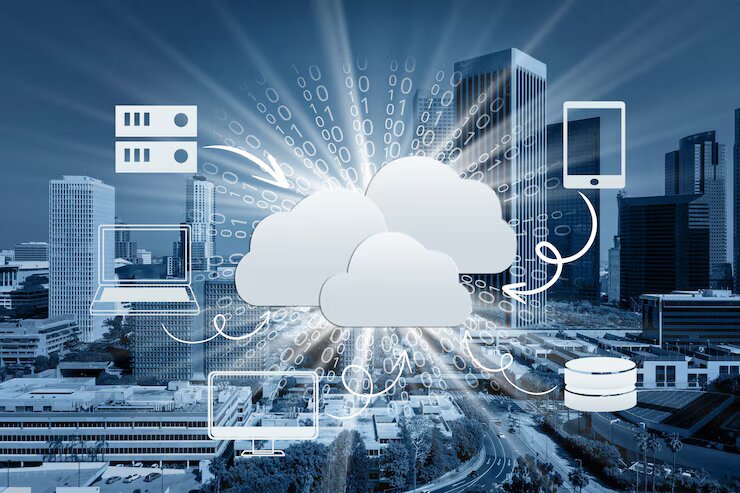Safeguarding data is crucial in an increasingly digital world. This blog explores the essentials of cloud disaster recovery, explaining how it works and why it might be vital for your business to ensure continuous operations and protect against data loss in catastrophic events.
What Is Cloud Disaster Recovery?
Cloud disaster recovery is a strategy that leverages cloud computing resources to protect and recover data and IT infrastructure during a disaster or outage. Unlike traditional disaster recovery methods that rely on on-premises infrastructure, cloud disaster recovery utilizes cloud-based services, such as backup storage, virtual machines, and recovery tools, to replicate and store critical data and applications offsite.
In the event of a disaster, businesses can quickly restore operations by accessing their data and applications from the cloud, minimizing downtime and ensuring business continuity. Cloud disaster recovery provides a cost-effective and reliable solution for organizations seeking to enhance their disaster preparedness and resilience in the face of unforeseen disruptions. For businesses in Colorado, Recovery Solutions provides customized cloud disaster recovery services, offering local expertise and scalable recovery options that align with regional industry needs.
Advantages of Cloud Disaster Recovery
Lower Total Cost Of Ownership
Cloud disaster recovery eliminates the need for costly on-premises infrastructure, such as secondary data centers and dedicated hardware, reducing capital expenses and operational costs associated with maintaining and managing redundant systems.
Additionally, cloud-based solutions allow businesses to scale resources based on demand and avoid upfront investments in hardware and software licenses.
Enhanced Flexibility & Scalability
Cloud disaster recovery allows businesses to tailor their recovery solutions to meet evolving needs and requirements. With cloud-based services, organizations can quickly scale resources up or down as needed, ensuring optimal performance and cost-effectiveness.
This flexibility enables businesses to adapt to changing workloads, growth patterns, and disaster recovery scenarios without the constraints of physical infrastructure limitations. The cloud migration benefits here lie in the seamless scalability and flexibility that cloud services provide, allowing businesses to grow without the burden of hardware limitations.
Improved Recovery Objectives
Cloud disaster recovery solutions typically offer faster recovery times and improved recovery point objectives (RPOs) and recovery time objectives (RTOs) compared to traditional on-premises solutions.
By leveraging cloud resources, businesses can replicate and store data and applications offsite in geographically diverse locations, reducing the risk of data loss and downtime in a disaster.
Types of Cloud Disaster Recovery Models
Multiple cloud disaster recovery models exist to accommodate diverse business needs, preferences, and budget constraints. Each model offers unique advantages and trade-offs, such as cost-effectiveness, scalability, and data control.
Type 1 - Backup and Restore
The Backup and Restore model of cloud disaster recovery involves regularly backing up data and applications from on-premises systems to the cloud, where they are stored securely and replicated across multiple geographic locations.
In the event of a disaster or data loss, businesses can quickly restore their systems and data from these cloud backups, minimizing downtime and ensuring business continuity. This model lets organizations protect critical assets and recover operations rapidly by offering the advantages of reduced capital expenses, scalable storage options, and automated backup processes.
Type 2 - Pilot Light
Like a pilot light in a gas appliance that remains lit and can quickly ignite a larger flame when needed, this approach ensures critical components, such as data backups, configurations, and essential services, are continuously running in the cloud.
When a disaster occurs, additional resources can be quickly provisioned to restore full functionality, minimizing downtime and ensuring business continuity. This model offers cost-effective disaster recovery while providing scalability and rapid response capabilities to meet recovery objectives.
Type 3 - Warm Standby
In a Warm Standby model of cloud disaster recovery, critical systems and data are replicated and maintained in a partially operational state in the cloud. Unlike a Hot Standby model, where systems are fully operational and continuously synchronized, a Warm Standby setup has a slight synchronization delay.
However, essential components are pre-configured and ready to be quickly activated in a disaster. This approach balances cost-effectiveness and recovery time, allowing businesses to minimize downtime while avoiding the higher costs of maintaining fully active standby systems.
Type 4 - Multi-Site
The Multi-Site model of cloud disaster recovery involves replicating data and applications across multiple geographically dispersed data centers or cloud regions. This approach offers enhanced redundancy and resilience, as it ensures that critical resources are stored in multiple locations, reducing the risk of data loss and downtime.
In the Multi-Site model, businesses can leverage the elasticity and scalability of cloud resources to replicate data in real-time or near-real-time, ensuring minimal data loss and maximizing recovery objectives. Organizations can achieve high availability and disaster recovery capabilities by distributing resources across multiple sites, ensuring business continuity despite widespread outages or disruptions.
By providing a range of options, businesses can select the model that best aligns with their requirements, ensuring optimal disaster recovery preparedness and resilience.
Steps to Implement Cloud Disaster Recovery
Implementing Cloud Disaster Recovery involves several crucial steps.
Step 1 - Conducting a Business Impact Analysis (BIA)
Assess the potential impact of disasters on your business, identifying critical systems, data, and processes. This analysis helps prioritize recovery efforts and determine recovery objectives.
Step 2 - Selecting the Right Cloud Provider
Choose a reputable and reliable cloud provider that offers robust disaster recovery services and meets your business requirements for scalability, availability, and security.
Step 3 - Setting Up and Configuring DR Solutions
Deploy and configure cloud-based disaster recovery solutions, such as backup and replication tools, to replicate data and applications to the cloud and establish failover capabilities.
Step 4 - Regular Maintenance and Testing
Conduct regular maintenance tasks, such as monitoring system health and updating configurations, to ensure optimal performance and reliability. Regularly test disaster recovery plans and procedures to validate their effectiveness and identify any areas for improvement.
Implement Cloud Disaster Recovery with ACT Today!
Safeguard your business with our comprehensive cloud security recovery solutions. ACT offers cutting-edge technologies and expert support to protect your data and applications in the cloud. We ensure business continuity and peace of mind with robust encryption, real-time replication, and seamless failover capabilities. Protect your cloud environment by reaching out to us today!
Also Read – All You Need to Know About Disaster Recovery
FAQ's
Cloud disaster recovery may only be a perfect fit for some businesses due to regulatory requirements, data sensitivity, and cost considerations. Still, it offers scalability, flexibility, and enhanced resilience for many organizations.
Cloud disaster recovery involves replicating critical data and systems to a cloud environment, enabling rapid recovery and restoration of IT infrastructure during a disaster.
Businesses should assess their data criticality, recovery time objectives (RTOs), and budget constraints to determine if cloud disaster recovery is necessary for ensuring minimal downtime and data loss.
Cloud disaster recovery can speed up recovery times after a disaster by providing scalable resources, automated processes, and geographically distributed data centers.
For businesses seeking cost-effective and scalable disaster recovery solutions, combining on-premises infrastructure with cloud resources, a hybrid cloud disaster recovery model offers flexibility and resilience to meet diverse business needs.





